жӮЁеҘҪпјҢзҷ»еҪ•еҗҺжүҚиғҪдёӢи®ўеҚ•е“ҰпјҒ
жӮЁеҘҪпјҢзҷ»еҪ•еҗҺжүҚиғҪдёӢи®ўеҚ•е“ҰпјҒ
иҝҷзҜҮж–Үз« дё»иҰҒд»Ӣз»ҚдәҶKerasеҮҪж•°ејҸAPIжҖҺд№ҲдҪҝз”Ёзҡ„зӣёе…ізҹҘиҜҶпјҢеҶ…е®№иҜҰз»Ҷжҳ“жҮӮпјҢж“ҚдҪңз®ҖеҚ•еҝ«жҚ·пјҢе…·жңүдёҖе®ҡеҖҹйүҙд»·еҖјпјҢзӣёдҝЎеӨ§е®¶йҳ…иҜ»е®ҢиҝҷзҜҮKerasеҮҪж•°ејҸAPIжҖҺд№ҲдҪҝз”Ёж–Үз« йғҪдјҡжңүжүҖ收иҺ·пјҢдёӢйқўжҲ‘们дёҖиө·жқҘзңӢзңӢеҗ§гҖӮ
е®ҡд№үдәҶз”ЁдәҺдәҢеҲҶзұ»зҡ„еӨҡеұӮж„ҹзҹҘеҷЁжЁЎеһӢгҖӮ
жЁЎеһӢиҫ“е…Ҙ32з»ҙзү№еҫҒпјҢз»ҸиҝҮдёүдёӘе…ЁиҝһжҺҘеұӮпјҢжҜҸеұӮдҪҝз”ЁreluзәҝжҖ§жҝҖжҙ»еҮҪж•°пјҢ并且еңЁиҫ“еҮәеұӮдёӯдҪҝз”ЁsigmoidжҝҖжҙ»еҮҪж•°пјҢжңҖеҗҺз”ЁдәҺдәҢеҲҶзұ»гҖӮ
##------ Multilayer Perceptron ------## from keras.models import Model from keras.layers import Input, Dense from keras import backend as K K.clear_session() # MLP model x = Input(shape=(32,)) hidden1 = Dense(10, activation='relu')(x) hidden2 = Dense(20, activation='relu')(hidden1) hidden3 = Dense(10, activation='relu')(hidden2) output = Dense(1, activation='sigmoid')(hidden3) model = Model(inputs=x, outputs=output) # summarize layers model.summary()
жЁЎеһӢзҡ„з»“жһ„е’ҢеҸӮж•°еҰӮдёӢпјҡ
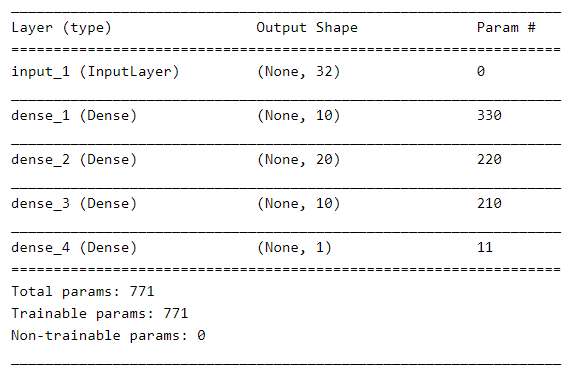
е®ҡд№үз”ЁдәҺеӣҫеғҸеҲҶзұ»зҡ„еҚ·з§ҜзҘһз»ҸзҪ‘з»ңгҖӮ
иҜҘжЁЎеһӢжҺҘ收3йҖҡйҒ“зҡ„64×64еӣҫеғҸдҪңдёәиҫ“е…ҘпјҢ然еҗҺз»ҸиҝҮдёӨдёӘеҚ·з§Ҝе’Ңжұ еҢ–еұӮзҡ„еәҸеҲ—дҪңдёәзү№еҫҒжҸҗеҸ–еҷЁпјҢжҺҘзқҖиҝҮдёҖдёӘе…ЁиҝһжҺҘеұӮпјҢжңҖеҗҺиҫ“еҮәеұӮиҝҮsoftmaxжҝҖжҙ»еҮҪж•°иҝӣиЎҢ10дёӘзұ»еҲ«зҡ„еҲҶзұ»гҖӮ
##------ Convolutional Neural Network ------## from keras.models import Model from keras.layers import Input from keras.layers import Dense, Flatten from keras.layers import Conv2D, MaxPooling2D from keras import backend as K K.clear_session() # CNN model x = Input(shape=(64,64,3)) conv1 = Conv2D(16, (5,5), activation='relu')(x) pool1 = MaxPooling2D((2,2))(conv1) conv2 = Conv2D(32, (3,3), activation='relu')(pool1) pool2 = MaxPooling2D((2,2))(conv2) conv3 = Conv2D(32, (3,3), activation='relu')(pool2) pool3 = MaxPooling2D((2,2))(conv3) flat = Flatten()(pool3) hidden1 = Dense(512, activation='relu')(flat) output = Dense(10, activation='softmax')(hidden1) model = Model(inputs=x, outputs=output) # summarize layers model.summary()
жЁЎеһӢзҡ„з»“жһ„е’ҢеҸӮж•°еҰӮдёӢпјҡ
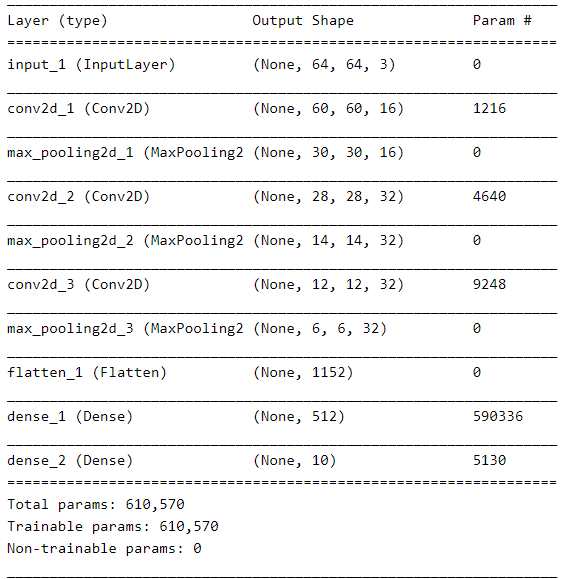
е®ҡд№үдёҖдёӘз”ЁдәҺж–Үжң¬еәҸеҲ—еҲҶзұ»зҡ„LSTMзҪ‘з»ңгҖӮ
иҜҘжЁЎеһӢйңҖиҰҒ100дёӘж—¶й—ҙжӯҘй•ҝдҪңдёәиҫ“е…ҘпјҢ然еҗҺз»ҸиҝҮдёҖдёӘEmbeddingеұӮпјҢжҜҸдёӘж—¶й—ҙжӯҘеҸҳжҲҗ128з»ҙзү№еҫҒиЎЁзӨәпјҢ然еҗҺз»ҸиҝҮдёҖдёӘLSTMеұӮпјҢLSTMиҫ“еҮәиҝҮдёҖдёӘе…ЁиҝһжҺҘеұӮпјҢжңҖеҗҺиҫ“еҮәз”ЁsigmoidжҝҖжҙ»еҮҪж•°з”ЁдәҺиҝӣиЎҢдәҢеҲҶзұ»йў„жөӢгҖӮ
##------ Recurrent Neural Network ------## from keras.models import Model from keras.layers import Input from keras.layers import Dense, LSTM, Embedding from keras import backend as K K.clear_session() VOCAB_SIZE = 10000 EMBED_DIM = 128 x = Input(shape=(100,), dtype='int32') embedding = Embedding(VOCAB_SIZE, EMBED_DIM, mask_zero=True)(x) hidden1 = LSTM(64)(embedding) hidden2 = Dense(32, activation='relu')(hidden1) output = Dense(1, activation='sigmoid')(hidden2) model = Model(inputs=x, outputs=output) # summarize layers model.summary()
жЁЎеһӢзҡ„з»“жһ„е’ҢеҸӮж•°еҰӮдёӢпјҡ
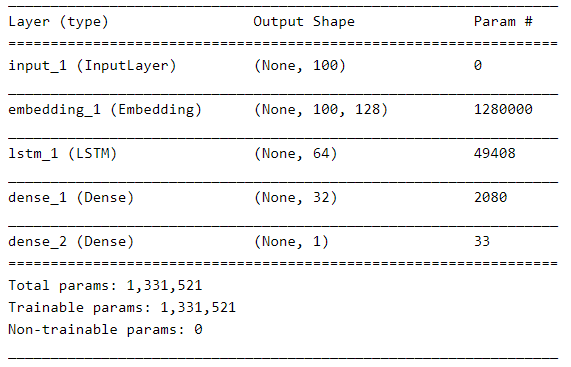
е®ҡд№үдёҖдёӘеҸҢеҗ‘еҫӘзҺҜзҘһз»ҸзҪ‘з»ңпјҢеҸҜд»Ҙз”ЁжқҘе®ҢжҲҗеәҸеҲ—ж ҮжіЁзӯүд»»еҠЎпјҢзӣёжҜ”дёҠйқўзҡ„LSTMзҪ‘з»ңпјҢеӨҡдәҶдёҖдёӘеҸҚеҗ‘зҡ„LSTMпјҢе…¶е®ғи®ҫзҪ®дёҖж ·гҖӮ
##------ Bidirectional recurrent neural network ------## from keras.models import Model from keras.layers import Input, Embedding from keras.layers import Dense, LSTM, Bidirectional from keras import backend as K K.clear_session() VOCAB_SIZE = 10000 EMBED_DIM = 128 HIDDEN_SIZE = 64 # input layer x = Input(shape=(100,), dtype='int32') # embedding layer embedding = Embedding(VOCAB_SIZE, EMBED_DIM, mask_zero=True)(x) # BiLSTM layer hidden = Bidirectional(LSTM(HIDDEN_SIZE, return_sequences=True))(embedding) # prediction layer output = Dense(10, activation='softmax')(hidden) model = Model(inputs=x, outputs=output) model.summary()
жЁЎеһӢзҡ„з»“жһ„е’ҢеҸӮж•°еҰӮдёӢпјҡ
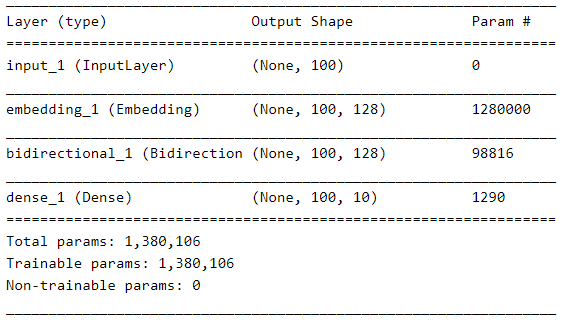
е®ҡд№үдәҶе…·жңүдёҚеҗҢеӨ§е°ҸеҶ…ж ёзҡ„еӨҡдёӘеҚ·з§ҜеұӮжқҘи§ЈйҮҠеӣҫеғҸиҫ“е…ҘгҖӮ
иҜҘжЁЎеһӢйҮҮз”Ёе°әеҜёдёә64×64еғҸзҙ зҡ„3йҖҡйҒ“еӣҫеғҸгҖӮ
жңүдёӨдёӘе…ұдә«жӯӨиҫ“е…Ҙзҡ„CNNзү№еҫҒжҸҗеҸ–еӯҗжЁЎеһӢ; 第дёҖдёӘеҶ…ж ёеӨ§е°Ҹдёә5x5пјҢ第дәҢдёӘеҶ…ж ёеӨ§е°Ҹдёә3x3гҖӮ
жҠҠжҸҗеҸ–зҡ„зү№еҫҒеұ•е№ідёәеҗ‘йҮҸ然еҗҺжӢјжҺҘжҲҗдёҖдёӘй•ҝеҗ‘йҮҸпјҢ然еҗҺиҝҮдёҖдёӘе…ЁиҝһжҺҘеұӮпјҢжңҖеҗҺиҫ“еҮәеұӮе®ҢжҲҗ10еҲҶзұ»гҖӮ
##------ Shared Input Layer Model ------## from keras.models import Model from keras.layers import Input from keras.layers import Dense, Flatten from keras.layers import Conv2D, MaxPooling2D, Concatenate from keras import backend as K K.clear_session() # input layer x = Input(shape=(64,64,3)) # first feature extractor conv1 = Conv2D(32, (3,3), activation='relu')(x) pool1 = MaxPooling2D((2,2))(conv1) flat1 = Flatten()(pool1) # second feature extractor conv2 = Conv2D(16, (5,5), activation='relu')(x) pool2 = MaxPooling2D((2,2))(conv2) flat2 = Flatten()(pool2) # merge feature merge = Concatenate()([flat1, flat2]) # interpretation layer hidden1 = Dense(128, activation='relu')(merge) # prediction layer output = Dense(10, activation='softmax')(merge) model = Model(inputs=x, outputs=output) model.summary()
жЁЎеһӢзҡ„з»“жһ„е’ҢеҸӮж•°еҰӮдёӢпјҡ
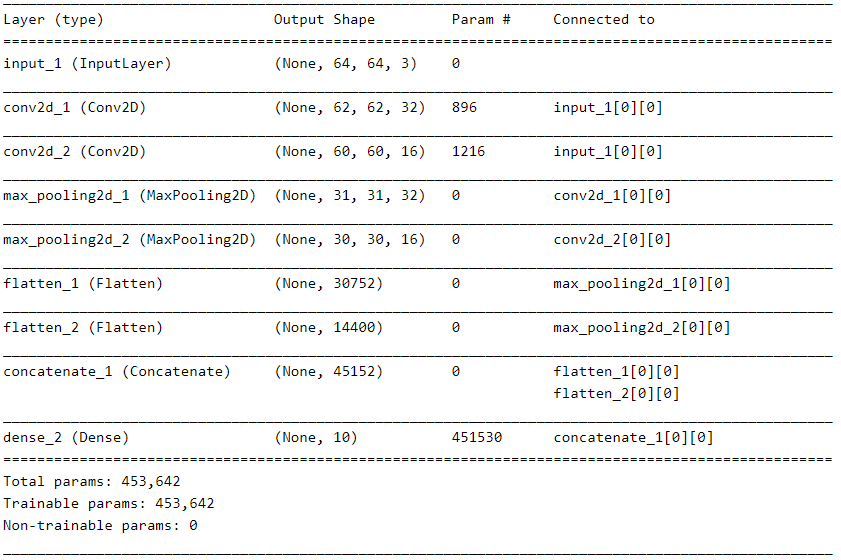
е®ҡд№үдёҖдёӘе…ұдә«зү№еҫҒжҠҪеҸ–еұӮзҡ„жЁЎеһӢпјҢиҝҷйҮҢе…ұдә«зҡ„жҳҜLSTMеұӮзҡ„иҫ“еҮәпјҢе…·дҪ“е…ұдә«еҸӮи§Ғд»Јз Ғ
##------ Shared Feature Extraction Layer ------## from keras.models import Model from keras.layers import Input, Embedding from keras.layers import Dense, LSTM, Concatenate from keras import backend as K K.clear_session() # input layer x = Input(shape=(100,32)) # feature extraction extract1 = LSTM(64)(x) # first interpretation model interp1 = Dense(32, activation='relu')(extract1) # second interpretation model interp11 = Dense(64, activation='relu')(extract1) interp12 = Dense(32, activation='relu')(interp11) # merge interpretation merge = Concatenate()([interp1, interp12]) # output layer output = Dense(10, activation='softmax')(merge) model = Model(inputs=x, outputs=output) model.summary()
жЁЎеһӢзҡ„з»“жһ„е’ҢеҸӮж•°еҰӮдёӢпјҡ
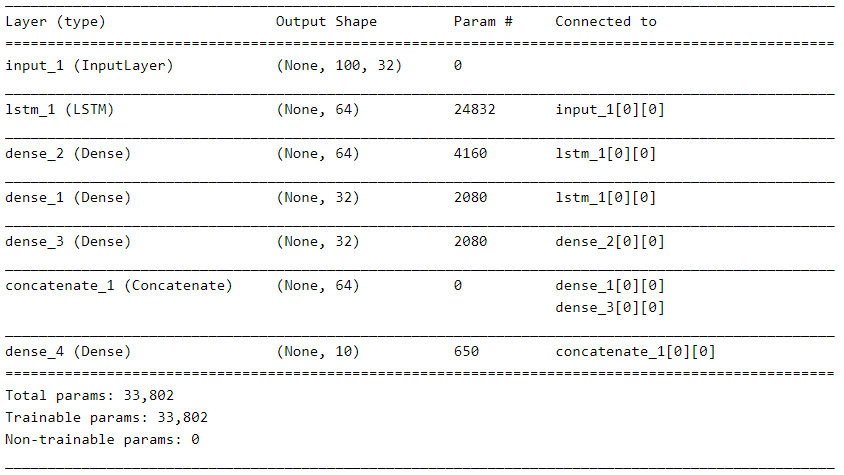
е®ҡд№үжңүдёӨдёӘиҫ“е…Ҙзҡ„жЁЎеһӢпјҢиҝҷйҮҢжөӢиҜ•зҡ„жҳҜиҫ“е…ҘдёӨеј еӣҫзүҮпјҢдёҖдёӘиҫ“е…ҘжҳҜеҚ•йҖҡйҒ“зҡ„64x64пјҢеҸҰдёҖдёӘжҳҜ3йҖҡйҒ“зҡ„32x32пјҢдёӨдёӘз»ҸиҝҮеҚ·з§ҜеұӮгҖҒжұ еҢ–еұӮеҗҺпјҢеұ•е№іжӢјжҺҘпјҢжңҖеҗҺиҝӣиЎҢдәҢеҲҶзұ»гҖӮ
##------ Multiple Input Model ------## from keras.models import Model from keras.layers import Input from keras.layers import Dense, Flatten from keras.layers import Conv2D, MaxPooling2D, Concatenate from keras import backend as K K.clear_session() # first input model input1 = Input(shape=(64,64,1)) conv11 = Conv2D(32, (5,5), activation='relu')(input1) pool11 = MaxPooling2D(pool_size=(2,2))(conv11) conv12 = Conv2D(16, (3,3), activation='relu')(pool11) pool12 = MaxPooling2D(pool_size=(2,2))(conv12) flat1 = Flatten()(pool12) # second input model input2 = Input(shape=(32,32,3)) conv21 = Conv2D(32, (5,5), activation='relu')(input2) pool21 = MaxPooling2D(pool_size=(2,2))(conv21) conv22 = Conv2D(16, (3,3), activation='relu')(pool21) pool22 = MaxPooling2D(pool_size=(2,2))(conv22) flat2 = Flatten()(pool22) # merge input models merge = Concatenate()([flat1, flat2]) # interpretation model hidden1 = Dense(20, activation='relu')(merge) output = Dense(1, activation='sigmoid')(hidden1) model = Model(inputs=[input1, input2], outputs=output) model.summary()
жЁЎеһӢзҡ„з»“жһ„е’ҢеҸӮж•°еҰӮдёӢпјҡ
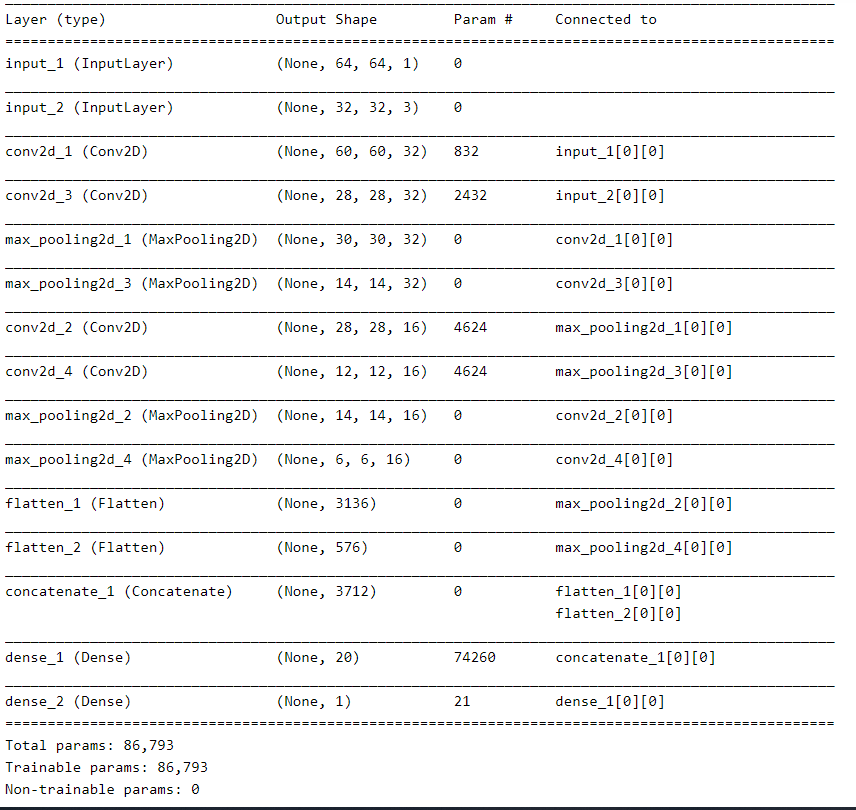
е®ҡд№үжңүеӨҡдёӘиҫ“еҮәзҡ„жЁЎеһӢпјҢд»Ҙж–Үжң¬еәҸеҲ—иҫ“е…ҘLSTMзҪ‘з»ңдёәдҫӢпјҢдёҖдёӘиҫ“еҮәжҳҜеҜ№ж–Үжң¬зҡ„еҲҶзұ»пјҢеҸҰеӨ–дёҖдёӘиҫ“еҮәжҳҜеҜ№ж–Үжң¬иҝӣиЎҢеәҸеҲ—ж ҮжіЁгҖӮ
##------ Multiple Output Model ------ ## from keras.models import Model from keras.layers import Input from keras.layers import Dense, Flatten, TimeDistributed, LSTM from keras.layers import Conv2D, MaxPooling2D, Concatenate from keras import backend as K K.clear_session() x = Input(shape=(100,1)) extract = LSTM(10, return_sequences=True)(x) class11 = LSTM(10)(extract) class12 = Dense(10, activation='relu')(class11) output1 = Dense(1, activation='sigmoid')(class12) output2 = TimeDistributed(Dense(1, activation='linear'))(extract) model = Model(inputs=x, outputs=[output1, output2]) model.summary()
жЁЎеһӢзҡ„з»“жһ„е’ҢеҸӮж•°еҰӮдёӢпјҡ
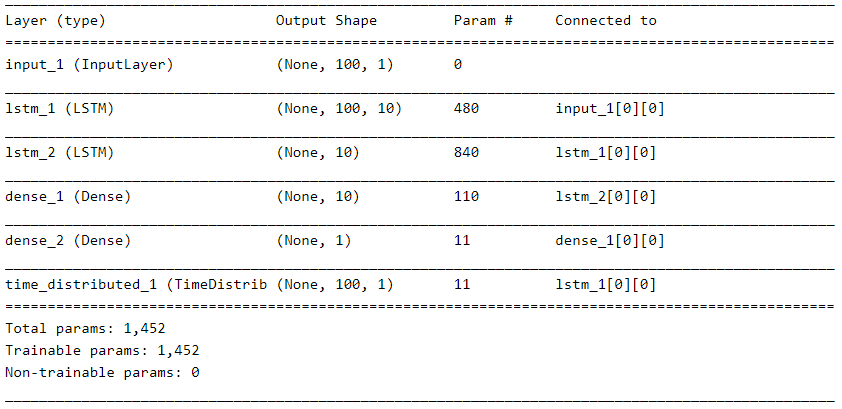
е…ідәҺвҖңKerasеҮҪж•°ејҸAPIжҖҺд№ҲдҪҝз”ЁвҖқиҝҷзҜҮж–Үз« зҡ„еҶ…е®№е°ұд»Ӣз»ҚеҲ°иҝҷйҮҢпјҢж„ҹи°ўеҗ„дҪҚзҡ„йҳ…иҜ»пјҒзӣёдҝЎеӨ§е®¶еҜ№вҖңKerasеҮҪж•°ејҸAPIжҖҺд№ҲдҪҝз”ЁвҖқзҹҘиҜҶйғҪжңүдёҖе®ҡзҡ„дәҶи§ЈпјҢеӨ§е®¶еҰӮжһңиҝҳжғіеӯҰд№ жӣҙеӨҡзҹҘиҜҶпјҢж¬ўиҝҺе…іжіЁдәҝйҖҹдә‘иЎҢдёҡиө„и®Ҝйў‘йҒ“гҖӮ
е…ҚиҙЈеЈ°жҳҺпјҡжң¬з«ҷеҸ‘еёғзҡ„еҶ…е®№пјҲеӣҫзүҮгҖҒи§Ҷйў‘е’Ңж–Үеӯ—пјүд»ҘеҺҹеҲӣгҖҒиҪ¬иҪҪе’ҢеҲҶдә«дёәдё»пјҢж–Үз« и§ӮзӮ№дёҚд»ЈиЎЁжң¬зҪ‘з«ҷз«ӢеңәпјҢеҰӮжһңж¶үеҸҠдҫөжқғиҜ·иҒ”зі»з«ҷй•ҝйӮ®з®ұпјҡis@yisu.comиҝӣиЎҢдёҫжҠҘпјҢ并жҸҗдҫӣзӣёе…іиҜҒжҚ®пјҢдёҖз»ҸжҹҘе®һпјҢе°Ҷз«ӢеҲ»еҲ йҷӨж¶үе«ҢдҫөжқғеҶ…е®№гҖӮ